|
RMNH3372 |
9482 |
|
|
PHX |
|
129 - National Natural History Museum, Naturalis, Leiden, The Netherlands (RMNH) |
|
|
|
-- |
Second phalanx of digit III. |
159 - R. Bernor |
|
|
Unknown |
|
Mammalia |
Perissodactyla |
Hippomorpha |
|
|
Equidae |
Equinae |
Hipparionini |
Eurygnathohippus |
|
|
Inventoried by Ray Bernor. Identified by Bernor as genus Eurygnathohippus. |
No |
|
RMNH36 |
9485 |
|
|
PHX |
|
129 - National Natural History Museum, Naturalis, Leiden, The Netherlands (RMNH) |
|
|
|
-- |
Second phalanx of digit III. |
159 - R. Bernor |
|
|
Unknown |
|
Mammalia |
Perissodactyla |
Hippomorpha |
|
|
Equidae |
Equinae |
Hipparionini |
Eurygnathohippus |
|
|
Inventoried by Ray Bernor. Identified by Bernor as genus Eurygnathohippus. |
No |
|
RMNH4 |
9490 |
|
|
PHX |
|
129 - National Natural History Museum, Naturalis, Leiden, The Netherlands (RMNH) |
|
|
|
-- |
Third phalanx of digit III. |
159 - R. Bernor |
|
|
Unknown |
|
Mammalia |
Perissodactyla |
Hippomorpha |
|
|
Equidae |
Equinae |
Hipparionini |
Eurygnathohippus |
|
|
Inventoried by Ray Bernor. Identified by Bernor as genus Eurygnathohippus. |
No |
|
RMNH4013 |
9491 |
|
|
PHX |
|
129 - National Natural History Museum, Naturalis, Leiden, The Netherlands (RMNH) |
|
|
|
-- |
Third phalanx of digit III. |
159 - R. Bernor |
|
|
Unknown |
|
Mammalia |
Perissodactyla |
Hippomorpha |
|
|
Equidae |
Equinae |
Hipparionini |
Eurygnathohippus |
|
|
Inventoried by Ray Bernor. Identified by Bernor as genus Eurygnathohippus. |
No |
|
RMNH48 |
9495 |
|
|
PHX |
|
129 - National Natural History Museum, Naturalis, Leiden, The Netherlands (RMNH) |
|
|
|
-- |
Second phalanx of digit III. |
159 - R. Bernor |
|
|
Unknown |
|
Mammalia |
Perissodactyla |
Hippomorpha |
|
|
Equidae |
Equinae |
Hipparionini |
Eurygnathohippus |
|
|
Inventoried by Ray Bernor. Identified by Bernor as genus Eurygnathohippus. |
No |
|
RMNH49 |
9497 |
|
|
PHX |
|
129 - National Natural History Museum, Naturalis, Leiden, The Netherlands (RMNH) |
|
|
|
-- |
Anterior first phalanx IV. |
159 - R. Bernor |
|
|
Unknown |
|
Mammalia |
Perissodactyla |
Hippomorpha |
|
|
Equidae |
Equinae |
Hipparionini |
Eurygnathohippus |
|
|
Inventoried by Ray Bernor. Identified by Bernor as genus Eurygnathohippus. |
No |
|
RMNH493 |
9498 |
|
|
PHX |
|
129 - National Natural History Museum, Naturalis, Leiden, The Netherlands (RMNH) |
|
|
|
-- |
Second phalanx of digit III. |
159 - R. Bernor |
|
|
Unknown |
|
Mammalia |
Perissodactyla |
Hippomorpha |
|
|
Equidae |
Equinae |
Hipparionini |
Eurygnathohippus |
|
|
Inventoried by Ray Bernor. Identified by Bernor as genus Eurygnathohippus. |
No |
|
RMNH505 |
9500 |
|
|
PHX |
|
129 - National Natural History Museum, Naturalis, Leiden, The Netherlands (RMNH) |
|
|
|
-- |
Anterior first phalanx IV. |
159 - R. Bernor |
|
|
Unknown |
|
Mammalia |
Perissodactyla |
Hippomorpha |
|
|
Equidae |
Equinae |
Hipparionini |
Eurygnathohippus |
|
|
Inventoried by Ray Bernor. Identified by Bernor as genus Eurygnathohippus. |
No |
|
RMNH516 |
9502 |
|
|
PHX |
|
129 - National Natural History Museum, Naturalis, Leiden, The Netherlands (RMNH) |
|
|
|
-- |
Second phalanx of digit III. |
159 - R. Bernor |
|
|
Unknown |
|
Mammalia |
Perissodactyla |
Hippomorpha |
|
|
Equidae |
Equinae |
Hipparionini |
Eurygnathohippus |
|
|
Inventoried by Ray Bernor. Identified by Bernor as genus Eurygnathohippus. |
No |
|
RMNH568 |
9519 |
|
|
PHX |
|
129 - National Natural History Museum, Naturalis, Leiden, The Netherlands (RMNH) |
|
|
|
-- |
Third phalanx of digit III. |
159 - R. Bernor |
|
|
Unknown |
|
Mammalia |
Perissodactyla |
Hippomorpha |
|
|
Equidae |
Equinae |
Hipparionini |
Eurygnathohippus |
|
|
Inventoried by Ray Bernor. Identified by Bernor as genus Eurygnathohippus. |
No |
|
RMNH575 |
9521 |
|
|
PHX |
|
129 - National Natural History Museum, Naturalis, Leiden, The Netherlands (RMNH) |
|
|
|
-- |
Second phalanx of digit III. |
159 - R. Bernor |
|
|
Unknown |
|
Mammalia |
Perissodactyla |
Hippomorpha |
|
|
Equidae |
Equinae |
Hipparionini |
Eurygnathohippus |
|
|
Inventoried by Ray Bernor. Identified by Bernor as genus Eurygnathohippus. |
No |
|
RMNH5843 |
9523 |
|
|
PHX |
|
129 - National Natural History Museum, Naturalis, Leiden, The Netherlands (RMNH) |
|
|
|
-- |
Posterior first phalanx IV. |
159 - R. Bernor |
|
|
Unknown |
|
Mammalia |
Perissodactyla |
Hippomorpha |
|
|
Equidae |
Equinae |
Hipparionini |
Eurygnathohippus |
|
|
Inventoried by Ray Bernor. Identified by Bernor as genus Eurygnathohippus. |
No |
|
RMNH589 |
9524 |
|
|
PHX |
|
129 - National Natural History Museum, Naturalis, Leiden, The Netherlands (RMNH) |
|
|
|
-- |
Third phalanx of digit III. |
159 - R. Bernor |
|
|
Unknown |
|
Mammalia |
Perissodactyla |
Hippomorpha |
|
|
Equidae |
Equinae |
Hipparionini |
Eurygnathohippus |
|
|
Inventoried by Ray Bernor. Identified by Bernor as genus Eurygnathohippus. |
No |
|
RMNH605 |
9528 |
|
|
PHX |
|
129 - National Natural History Museum, Naturalis, Leiden, The Netherlands (RMNH) |
|
|
|
-- |
Anterior first phalanx IV. |
159 - R. Bernor |
|
|
Unknown |
|
Mammalia |
Perissodactyla |
Hippomorpha |
|
|
Equidae |
Equinae |
Hipparionini |
Eurygnathohippus |
|
|
Inventoried by Ray Bernor. Identified by Bernor as genus Eurygnathohippus. |
No |
|
RMNH65 |
9535 |
|
|
PHX |
|
129 - National Natural History Museum, Naturalis, Leiden, The Netherlands (RMNH) |
|
|
|
-- |
Third phalanx of digit III. |
159 - R. Bernor |
|
|
Unknown |
|
Mammalia |
Perissodactyla |
Hippomorpha |
|
|
Equidae |
Equinae |
Hipparionini |
Eurygnathohippus |
|
|
Inventoried by Ray Bernor. Identified by Bernor as genus Eurygnathohippus. |
No |
|
RMNH700 |
9543 |
|
|
PHX |
|
129 - National Natural History Museum, Naturalis, Leiden, The Netherlands (RMNH) |
|
|
|
-- |
Third phalanx of digit III. |
159 - R. Bernor |
|
|
Unknown |
|
Mammalia |
Perissodactyla |
Hippomorpha |
|
|
Equidae |
Equinae |
Hipparionini |
Eurygnathohippus |
|
|
Inventoried by Ray Bernor. Identified by Bernor as genus Eurygnathohippus. |
No |
|
RMNH712 |
9545 |
|
|
PHX |
|
129 - National Natural History Museum, Naturalis, Leiden, The Netherlands (RMNH) |
|
|
|
-- |
Third phalanx of digit III. |
159 - R. Bernor |
|
|
Unknown |
|
Mammalia |
Perissodactyla |
Hippomorpha |
|
|
Equidae |
Equinae |
Hipparionini |
Eurygnathohippus |
|
|
Inventoried by Ray Bernor. Identified by Bernor as genus Eurygnathohippus. |
No |
|
RMNH80 |
9559 |
|
|
PHX |
|
129 - National Natural History Museum, Naturalis, Leiden, The Netherlands (RMNH) |
|
|
|
-- |
Posterior first phalanx IV. |
159 - R. Bernor |
|
|
Unknown |
|
Mammalia |
Perissodactyla |
Hippomorpha |
|
|
Equidae |
Equinae |
Hipparionini |
Eurygnathohippus |
|
|
Inventoried by Ray Bernor. Identified by Bernor as genus Eurygnathohippus. |
No |
|
RMNH886 |
9570 |
|
|
PHX |
|
129 - National Natural History Museum, Naturalis, Leiden, The Netherlands (RMNH) |
|
|
|
-- |
First phalanx of digit III. |
159 - R. Bernor |
|
|
Unknown |
|
Mammalia |
Perissodactyla |
Hippomorpha |
|
|
Equidae |
Equinae |
Hipparionini |
Eurygnathohippus |
|
|
Inventoried by Ray Bernor. Identified by Bernor as genus Eurygnathohippus. |
No |
|
RMNH936 |
9577 |
|
|
PHX |
|
129 - National Natural History Museum, Naturalis, Leiden, The Netherlands (RMNH) |
|
|
|
-- |
Posterior first phalanx IV. |
159 - R. Bernor |
|
|
Unknown |
|
Mammalia |
Perissodactyla |
Hippomorpha |
|
|
Equidae |
Equinae |
Hipparionini |
Eurygnathohippus |
|
|
Inventoried by Ray Bernor. Identified by Bernor as genus Eurygnathohippus. |
No |
|
RMNH939 |
9578 |
|
|
PHX |
|
129 - National Natural History Museum, Naturalis, Leiden, The Netherlands (RMNH) |
|
|
|
-- |
Third phalanx of digit III. |
159 - R. Bernor |
|
|
Unknown |
|
Mammalia |
Perissodactyla |
Hippomorpha |
|
|
Equidae |
Equinae |
Hipparionini |
Eurygnathohippus |
|
|
Inventoried by Ray Bernor. Identified by Bernor as genus Eurygnathohippus. |
No |
|
RMNHF832 |
9583 |
|
|
PHX |
|
129 - National Natural History Museum, Naturalis, Leiden, The Netherlands (RMNH) |
|
|
|
-- |
Anterior first phalanx IV. |
159 - R. Bernor |
|
|
Unknown |
|
Mammalia |
Perissodactyla |
Hippomorpha |
|
|
Equidae |
Equinae |
Hipparionini |
Eurygnathohippus |
|
|
Inventoried by Ray Bernor. Identified by Bernor as genus Eurygnathohippus. |
No |
|
OH 14 |
3729 |
27 - MNK |
287 - 88 "Skull Site" |
CRA-f
, FRO-f
, R-PAR-f |
1963 |
122 - National Museum and House of Culture, Dar es Salaam, Tanzania |
II |
Lower Middle B |
Surface. Inferred as same horizon as OH 13 (Leakey MD, 1971). |
Leakey, L.S.B., Tobias, P.V. & Napier, J.R. 1964. A new species of the genus Homo from Olduvai Gorge. Nature 202(4927): 7-9. |
Juvenile (sutures unfused). Thin skull. Specimen previously housed at National Museum of Kenya. 11 pieces found at House of Culture, Dar es Salaam, Tanzania. |
130 - L.S.B. Leakey |
|
264 - Leakey family expedition |
No |
|
Mammalia |
Primates |
Anthropoidea |
Haplorhini |
Hominoidea |
Hominidae |
|
|
|
|
|
Juvenile, parietal is thin. |
No |
|
OH 25 |
3740 |
|
268 - 54 |
L-PAR-f |
1968 |
122 - National Museum and House of Culture, Dar es Salaam, Tanzania |
IV |
a |
Surface |
Leakey MD. (1971) Olduvai Gorge, Vol. 3: excavations in Beds I & II 1960-1963. New York, NY: Cambridge University Press. |
Left parietal fragment ca. asterion. Specimen previously housed at National Museum of Kenya. |
142 - M. D. Leakey |
|
264 - Leakey family expedition |
No |
|
Mammalia |
Primates |
Anthropoidea |
Haplorhini |
Hominoidea |
Hominidae |
|
|
|
|
|
Juvenile. |
No |
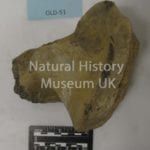 |
OLD-51 |
12683 |
|
|
PHX |
|
114 - Natural History Museum UK |
|
|
|
-- |
OLD-51; pedal bone |
|
|
|
Unknown |
|
Mammalia |
|
|
|
|
|
|
|
|
|
|
large mammal |
No |
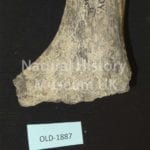 |
OLD-1887 |
13215 |
|
|
PVG-f |
|
114 - Natural History Museum UK |
|
|
|
-- |
OLD-1887; os coxae-f |
|
|
|
Unknown |
|
Mammalia |
|
|
|
|
|
|
|
|
|
|
large mammal |
Unknown |
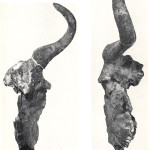 |
M. 21447 |
181 |
23 - TK |
|
CRA, L/R-MAX-f, L-HOR, L/R-P, L/R-M, L/R-I |
1931 |
106 - Natural History Museum UK (?) |
III, IV |
|
4 feet below Masek Beds |
Leakey LSB. 1965. Olduvai Gorge 1951-1961, Volume 1: Fauna and Background. New York, NY: Cambridge University Press. |
This neotype specimen is pictured in plates 81 and 82. The original holotype of M. kattwinkelli (VI-1099) was lost in WWII in Munich. |
130 - L.S.B. Leakey |
|
264 - Leakey family expedition |
Unknown |
|
Mammalia |
Artiodactyla |
Ruminantia |
|
Bovoidea |
Bovidae |
Alcelaphinae |
Alcelaphini |
Xenocephalus |
kattwinkelli |
|
Neotype - This specimen was reclassified by Gentry and Gentry (1978) as Megalotragus kattwinkeli. |
No |
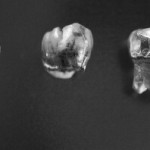 |
OH 68 |
3783 |
18 - VEK |
|
Mand-f, R-P-f |
2001 |
127 - National Natural History Museum, Arusha, Tanzania |
II |
Lower |
|
|
Mandible fragment with unerupted P4 and root of M1.�Specimen is pictured in the middle in image 1.�Specimen is shown in the middle of the top row in image 2. |
|
|
|
Yes |
|
Mammalia |
Primates |
Anthropoidea |
Haplorhini |
Hominoidea |
Hominidae |
|
|
Australopithecus |
africanus |
|
OH 13-like |
No |
|
OVPP-Erinaceus 94 |
1944 |
7 - FLK North |
|
MAX-f, P, M |
|
104 - Unknown |
I |
upper |
3 |
Butler, P., and Greenwood, M. 1973. The early Pleistocene hedgehogs from Olduvai, Tanzania. Fossil vertebrates of Africa 3:7-42. |
|
150 - Butler and Greenwood |
|
|
Unknown |
|
Mammalia |
Lipotyphya |
|
|
Erinaceoidea |
Erinaceidae |
Erinaceinae |
|
Erinaceus |
broomi |
|
Order has more recently been determined as Insectivora |
No |
|
M. 14686 |
1349 |
|
|
R-MAN, R-P, R-M |
|
106 - Natural History Museum UK (?) |
II |
|
|
Hopwood, A. 1934. New fossil mammals from Olduvai, Tanganyika territory. Annals of the Magazine of Natural History. 10: 546-550. |
The author suggests this specimen is "probably" from Bed II. |
293 - A.T. Hopwood |
|
|
Unknown |
|
Mammalia |
Artiodactyla |
Ruminantia |
|
Giraffoidea |
Giraffidae |
|
|
Helladotherium |
olduvaiensis |
|
Paratype |
No |
|
OLD 1960 F200 |
3714 |
5 - FLK |
|
R-MAN-f, d-P, M |
1960 |
105 - National Museum and House of Culture, Dar es Salaam, Tanzania (?) |
I |
|
|
Harris, J. M., Solounias, N., and Geraads, D. 2010. Giraffoidea. Werdelin, L., Sanders, W. J., eds. In: Cenozoic Mammals of Africa. London: University of California Press. pp. 393-428. |
Original information indicated that this specimen was located in Nairobi. This specimen is likely within the material that was repatriated to Dar in 2011, but this has yet to be confirmed. |
155 - Harris, Solounias, and Geraads |
|
264 - Leakey family expedition |
Unknown |
|
Mammalia |
Artiodactyla |
Ruminantia |
|
Giraffoidea |
Giraffidae |
Giraffinae |
Giraffini |
Giraffa |
pygmaea |
|
Paratype |
No |
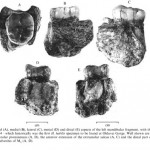 |
OH 4 |
3720 |
8 - MK |
281 - 11 |
P
, M
, MAN |
1959 |
122 - National Museum and House of Culture, Dar es Salaam, Tanzania |
I |
Lower |
Surface. |
Leakey, L.S.B., Tobias, P.V. & Napier, J.R. 1964. A new species of the genus Homo from Olduvai Gorge. Nature 202(4927): 7-9. |
Paratype. Two isolated teeth (lower molar and upper premolar) and one M3 in a mandible. Found in small block of consolidated tuff. �Specimen previously housed at National Museum of Kenya. |
282 - H. Mukiri |
|
264 - Leakey family expedition |
Yes |
|
Mammalia |
Primates |
Anthropoidea |
Haplorhini |
Hominoidea |
Hominidae |
Homininae |
Hominini |
Homo |
habilis |
|
Paratype |
No |
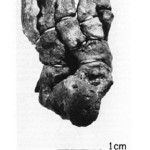 |
OH 8 |
3723 |
6 - FLK NN |
283 - 45 |
PHX
, CAR
, TAR
, CLA
, AST
, CAL
, CUNE
, CUB
, NAV
, M-f |
1960 |
122 - National Museum and House of Culture, Dar es Salaam, Tanzania |
I |
3 |
|
Leakey MD. (1971) Olduvai Gorge, Vol. 3: excavations in Beds I & II 1960-1963. New York, NY: Cambridge University Press. |
The molar-f was found on the surface and "probably also belongs to OH 8" (Leakey MD, 1971:228). Twelve associated foot bones including astragalus (has carnivore tooth marks (Leakey MD, 1971), calcaneus, cuboid and navicular, cuneiforms 1- 3, proximal ends with shafts, five metatarsals. Proximal ends of one metacarpal and three finger phalanges. One radius shaft. Clavicle with damaged articular ends. Foot articulates "almost perfectly with the OH 35 leg" (Susman, 1983:372). |
130 - L.S.B. Leakey |
|
264 - Leakey family expedition |
Yes |
|
Mammalia |
Primates |
Anthropoidea |
Haplorhini |
Hominoidea |
Hominidae |
Homininae |
Hominini |
Homo |
habilis |
|
Paratype |
No |
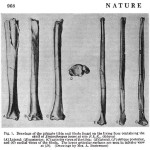 |
OH 6 |
3721 |
5 - FLK |
283 - 45 |
CRA-f
, M-f
, L-P
, L-TIB-f
, L-FIB-f
, |
1959/60 |
122 - National Museum and House of Culture, Dar es Salaam, Tanzania |
I |
Middle (Zinj.) |
Surface. Cranial and dental fragments found in surface soil from slope immediately below Zinj. site; assumed to be from Zinj. level (Leakey, MD, 1971:227). TIB-f and FIB-f from Zinj. level. |
Davis, P. R. 1964. Hominid fossils from Bed I, Olduvai Gorge, Tanganyika. A tibia and fibula. Nature. 201, 967. |
From Tobias (1991): OH 35 tibia and fibula attributed to same individual as OH 6 but appear to be more mature. It is unclear if OH 35 tibia and fibula are the same tibia and fibula originally listed under OH 6. Leakey, MD, 1971 describes CRA and dental fragments as having been found in surface soil, but Leakey, Tobias, and Napier, 1964 state "some [were] found in situ [and] some on the surface" (:9). Unworn lower L-P3. Partially developed roots of upper M1 or 2. Six cranial vault fragments. Tibia and fibula fragments first assumed to be associated with Zinjanthropus OH5, but should be considered associates with OH 6 following morphological study (Leakey, MD, 1971:227). and skull fragments. Juvenile. Specimen previously housed at National Museum of Kenya. |
|
|
264 - Leakey family expedition |
Unknown |
|
Mammalia |
Primates |
Anthropoidea |
Haplorhini |
Hominoidea |
Hominidae |
Homininae |
Hominini |
Homo |
habilis |
|
Paratype. TIB-f and FIB-f not given taxonomic designation in original publication (Davis, 1964) but named as a paratype in Leakey, Tobias, and Napier, 1964. |
No |
|
M. 14683 |
10383 |
|
|
Two upper tusks, probably of the same individual. |
1934 |
106 - Natural History Museum UK (?) |
I |
lower part, Middle Pleistocene |
Kamasian Pluvial |
LSB Leakey. 1958. Fossil Mammals of Africa: Some East African Pleistocene Suidae. British Museum. No. 14. |
British Museum Palaeontology Department |
130 - L.S.B. Leakey |
1942 |
|
Unknown |
|
Mammalia |
Artiodactyla |
Suiformes |
|
Suoidea |
Suidae |
|
|
Potamochoerus |
majus |
|
Paratypes. Originally classified as Koiropotamus majus (Hopwood, 1934). Reclassified as Potamochoerus majus (Leakey, 1942). |
Yes |
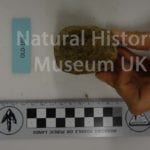 |
OLD-166 |
12456 |
|
|
PHX |
|
114 - Natural History Museum UK |
|
|
|
-- |
OLD-166; pedal bone |
|
|
|
Unknown |
|
Mammalia |
Perissodactyla |
Ceratomorpha |
Tapiromorpha |
Rhinocerotoidea |
Rhinocerotidae |
|
|
|
|
|
reptile pedal bone? |
Unknown |
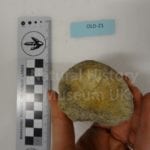 |
OLD-21 |
12490 |
|
|
PHX |
|
114 - Natural History Museum UK |
|
|
|
-- |
OLD-21 |
|
|
|
Unknown |
|
Mammalia |
|
|
|
|
|
|
|
|
|
|
Rhino? In rhino drawer |
Unknown |
|
OVPP-Muridae 4 |
40 |
7 - FLK North |
|
P, M, I, C |
|
104 - Unknown |
I |
upper |
1, 2, 3, 4, 5, 6 |
Leakey LSB. 1965. Olduvai Gorge 1951-1961, Volume 1: Fauna and Background. New York, NY: Cambridge University Press. |
Several specimens of unidentified murids are present. |
130 - L.S.B. Leakey |
|
264 - Leakey family expedition |
Unknown |
|
Mammalia |
Rodentia |
Myomorpha |
Myodonta |
Muroidea |
Muridae |
|
|
|
|
|
The author is unsure of the taxonomy. |
No |
|
F85 |
3015 |
6 - FLK NN |
|
EPLS |
|
105 - National Museum and House of Culture, Dar es Salaam, Tanzania (?) |
I |
|
|
Auffenberg, W. 1981. The fossil turtles of Olduvai Gorge, Tanzania, Africa. Copeia 1981:509-522. |
Original information indicated that this specimen was located in Nairobi. This specimen is likely within the material that was repatriated to Dar in 2011, but this has yet to be confirmed. |
152 - W. Auffenberg |
|
264 - Leakey family expedition |
Unknown |
|
Reptilia |
Testudines |
|
|
|
|
|
|
|
|
|
The author mentions there are over 3,000 fossilized turtle fragments from Olduvai Gorge, 98% of which are from the species Pelusios sinuatus. However, it is unclear which specimens belong to which species based on the description given. When it was unclear, the specimen is only referred to as belonging to the Order Testudines. |
No |
|
F173 |
3016 |
6 - FLK NN |
|
LIMB, ENPS |
|
105 - National Museum and House of Culture, Dar es Salaam, Tanzania (?) |
I |
|
|
Auffenberg, W. 1981. The fossil turtles of Olduvai Gorge, Tanzania, Africa. Copeia 1981:509-522. |
Original information indicated that this specimen was located in Nairobi. This specimen is likely within the material that was repatriated to Dar in 2011, but this has yet to be confirmed. |
152 - W. Auffenberg |
|
264 - Leakey family expedition |
Unknown |
|
Reptilia |
Testudines |
|
|
|
|
|
|
|
|
|
The author mentions there are over 3,000 fossilized turtle fragments from Olduvai Gorge, 98% of which are from the species Pelusios sinuatus. However, it is unclear which specimens belong to which species based on the description given. When it was unclear, the specimen is only referred to as belonging to the Order Testudines. |
No |








